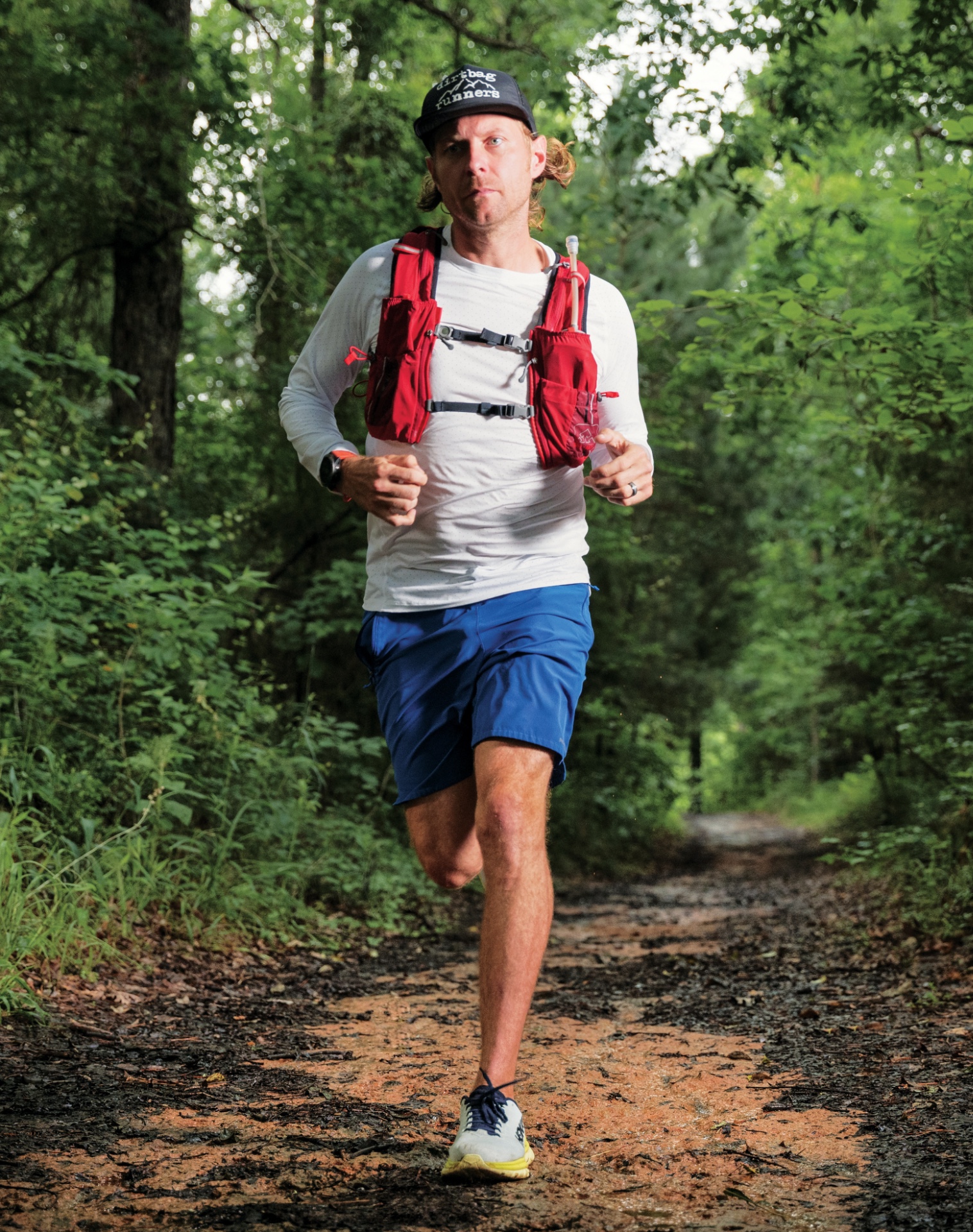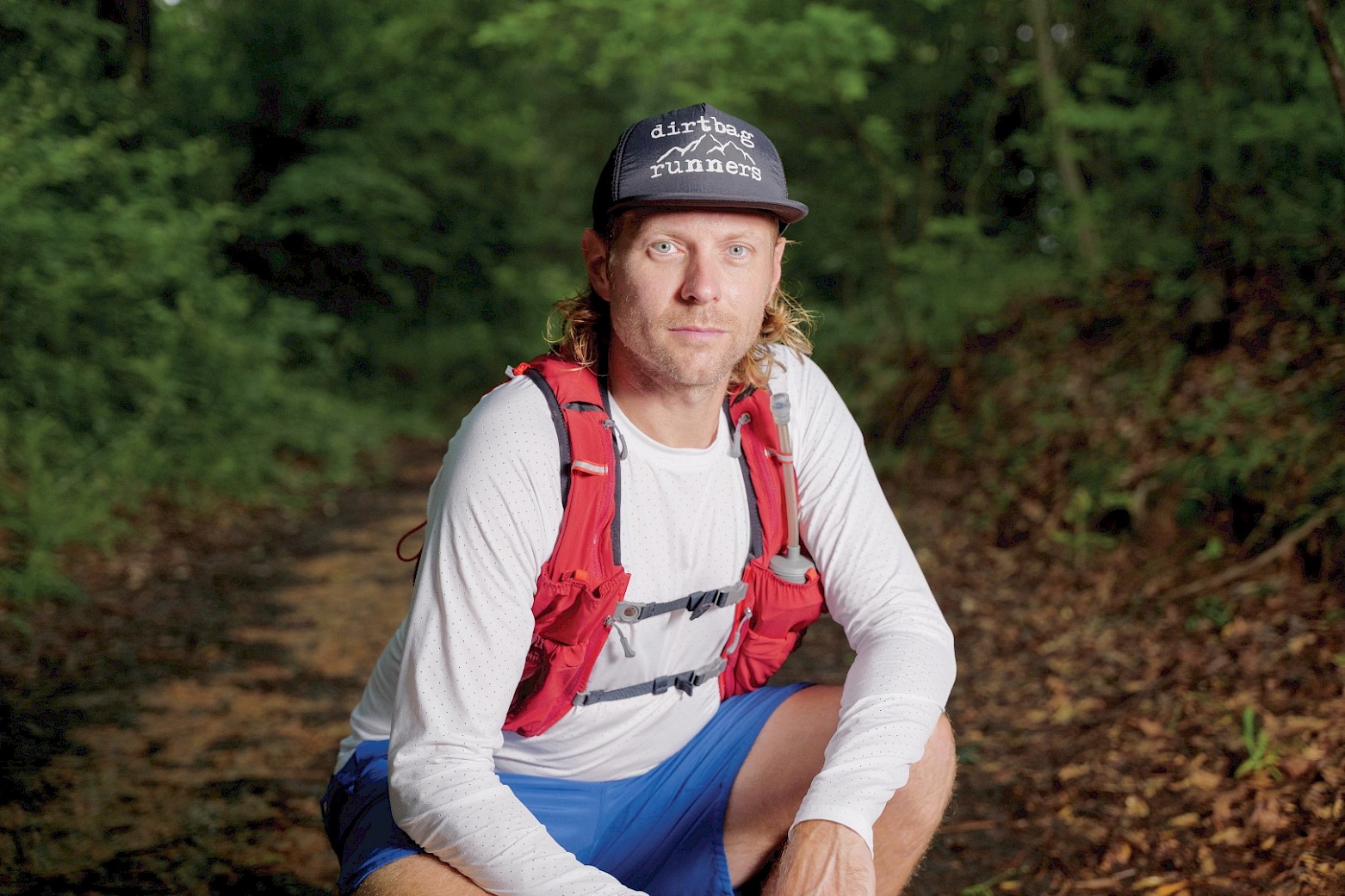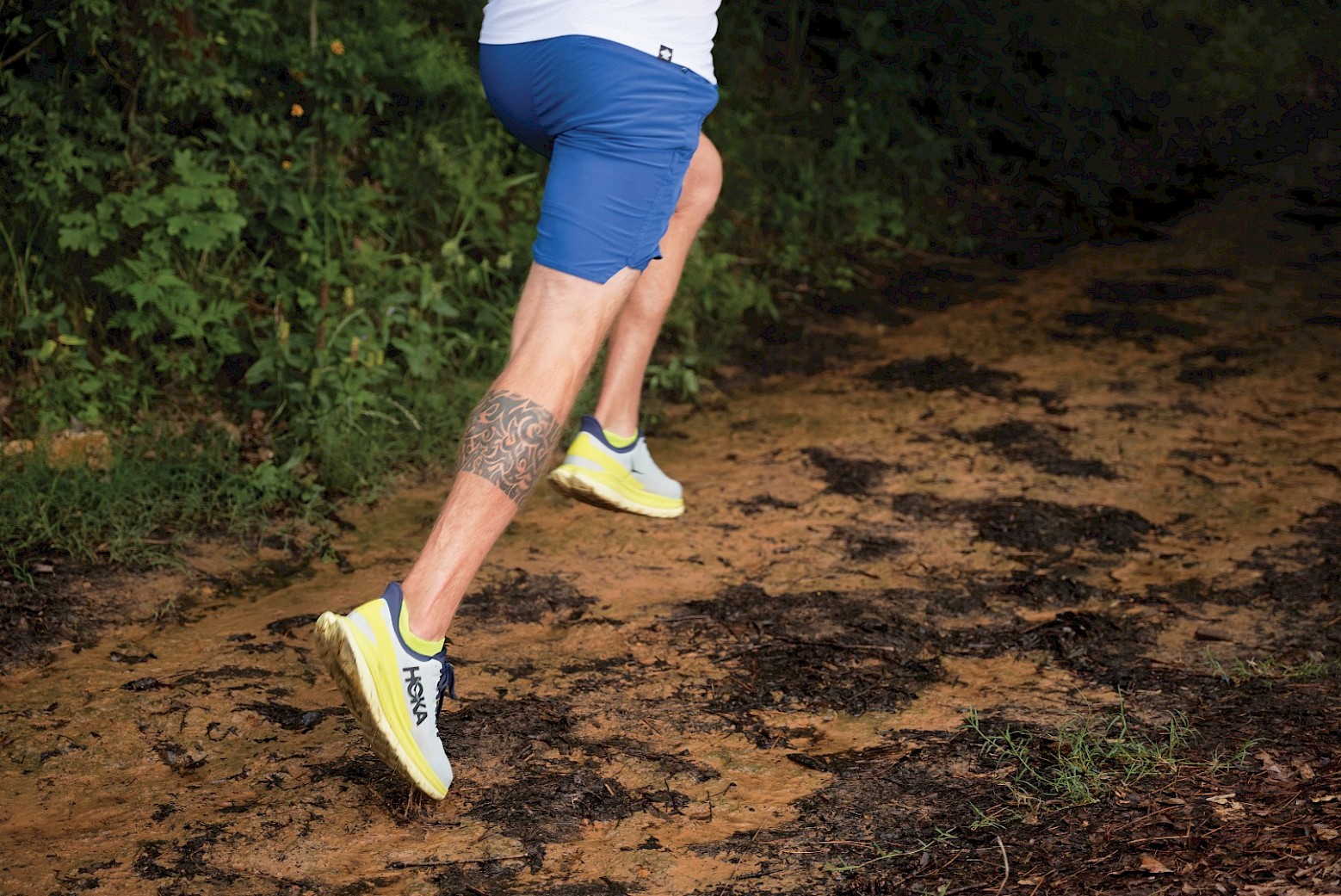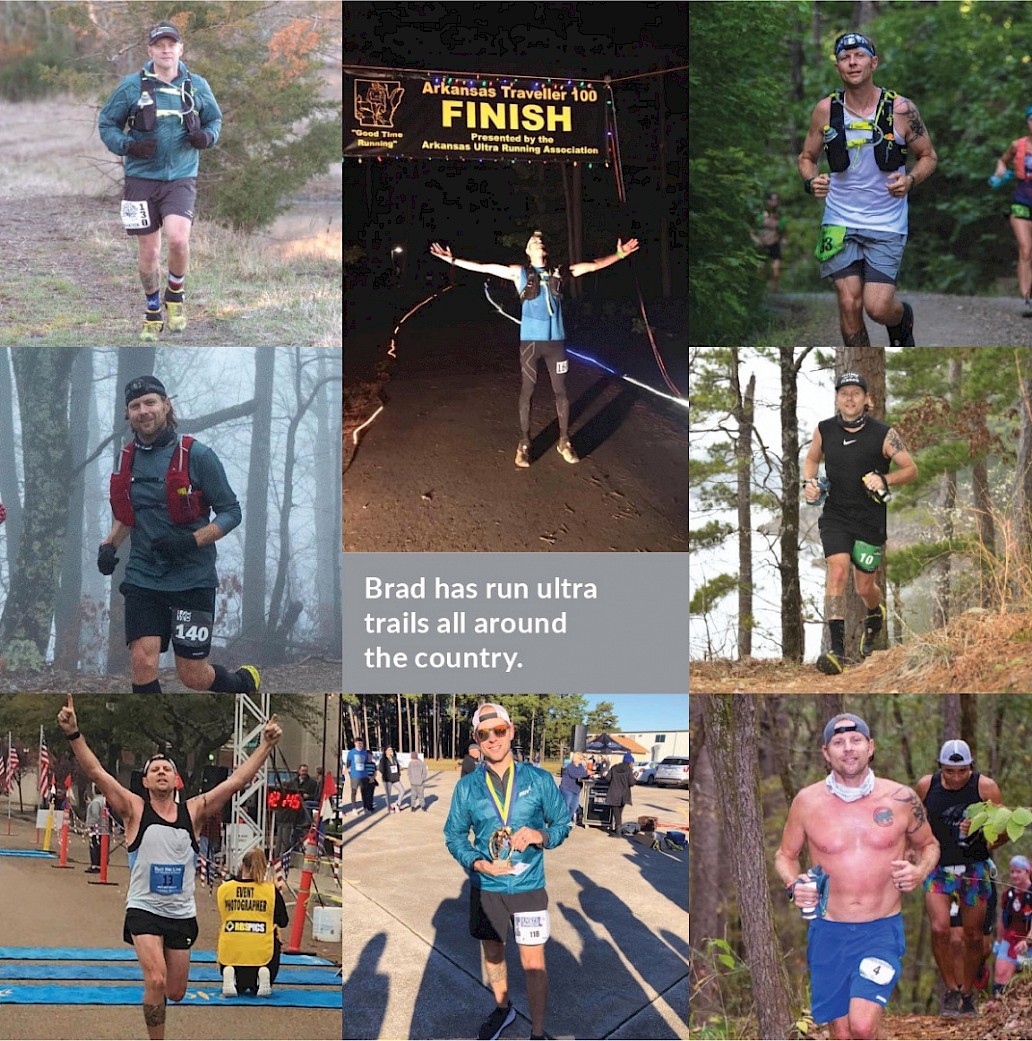Living Ultra

The sun sinks behind a curtain of trees as your heart pounds along with your feet battling the rugged terrain. You know there’s someone behind you, so you’ve got to stay ahead. You can’t stop. Time seems exponential and your vision is muddled.
“Will I make it?”
For most people, this nightmare is a fleeting dream, but for local father of three, Brad Taylor, it’s his reality and hobby.
Taylor is what’s known as a “trail ultra-runner,” running distances of over marathon length (26.2 miles) in a single outing. He began the sport three years ago to manage his physical and mental health. Now, at 41 years old, he has competed in over 20 ultra marathons and garnered several accolades.
“I’ve run 22 ultra marathons since I started running, including the Arkansas Traveler 100 miler, Walnut Grove Last Person Standing [I went 104 miles and won], LOViT 100 miler, Running the Rose 108k [66 miles] and many others,” said Taylor. “I took a brief respite from the trail in early 2020 and took to road running. I ran the Houston Marathon in two hours and 58 minutes which qualified me for the Boston Marathon.”
He says another personal achievement he is proud of is winning the Skull Crusher Challenge on the Eagle Rock Loop and setting the “Fastest Known Time” for anyone who has ever run the course. “I also competed in ‘Run the Line’ here in Texarkana,” said Taylor, “and ran a one hour, 21-minute half-marathon and was the top Texarkana finisher.”
Bringle Park has an excellent system of trails. You can get upwards of 18 miles on the trails if you run them properly.” —Brad Taylor
Ultra trail running is a different beast, and Taylor considers it as the most extreme of the endurance sports out there. “Imagine running for three days straight with maybe two hours of sleep across an entire 72-hour period covering distances of 250 miles [or more],” said Taylor. “It takes mental fortitude and body training unparalleled by any other sport. There are much shorter distances, but the 100-mile [or more] events are really the ones that test your ability to keep pushing when you feel there’s nothing left.”
Races take place on lengthy, and often hazardous, courses. The danger comes from uneven and unpaved terrain on these trails. Any misstep is possibly devastating, and since the sport is not seasonal, running in unfavorable weather is normal. Snow, rain, heat or cold do not stop them. “I’ve run on mountain sides that could end in death with one false foot placement,” said Taylor. “We run in extreme conditions and come face-to-face with threats of heat stroke and frostbite. Not to mention, we always have to be mindful of wildlife such as snakes, bears and big cats. We are constantly jumping over rocks and logs, and tripping is a real threat. Several runners have broken bones, knocked out teeth and received lacerations that need stitches. Fortunately, I’ve never had a serious injury.”
It is a somewhat solitary sport; once the race begins, cheering fans dissipate. It is also less popular. Taylor says competitions range from as many as 1,000 competitors, to some as few as ten. “In training, it’s usually just you and nature. A race is much different,” said Taylor. “At the start line of a race, there will be many people there cheering you on. Once you get out on the trail, you most likely won’t see many people cheering until you come to an aid station, which could be four to ten miles later. Because of the distances we run in most of these races, the aid stations will be stocked with all kinds of food to keep our calorie supply up while we are running extremely long miles.”

Stamina is key for all sports, but endurance tests more than your lungs; it requires a powerful body and mind that isn’t achieved on a treadmill. “I have a very detailed running and fitness plan that leads up to a race,” said Taylor. “I balance out trail running with road running, mixing in slow, longer runs and fast, shorter runs. I’ll run as much as 100 miles a week to be ready. The whole time I’ll be dialing in my nutrition to make sure that my stomach can handle what I’m feeding it when I’m running long events. The digestive system can have a lot of trouble when put through that kind of trauma, so I need to know what works during a run and what doesn’t.”
It does not take a superhero to have the courage to confront a superhuman amount of miles. For Taylor, the sport allowed him to take control, and conversely, free himself. “I was overweight and battling depression,” said Taylor. “I loved hiking in the mountains of Arkansas and decided to try to run those trails. It caused me to lose 60 pounds and gave me a form of therapy I couldn’t get anywhere else that helped keep depression at bay; running in nature cleared my head. I also found that I was good at it and soon began racing.”
Most ultra-runners have regular careers and compete recreationally. Taylor is no different, working as a driver for
Coca-Cola in Texarkana. What began as an extreme hobby for self care morphed into a vital outlet and passion. “There are not many better feelings than the ones I get when I’m running next to a river, listening to its flow and not having a care in the world,” said Taylor. “When I’m through, despite being physically tired, my brain feels renewed and fresh. It keeps me sane.”
For those considering joining the sport or getting in shape, Bringle Park has an excellent system of trails and Taylor says, “you can get upwards of 18 miles on the trails if you run them properly.” He also enjoys a mountain bike trail in Atlanta, Texas, “that is very hilly and is a great place to go to work on building your hill running strength.” On the weekends, he drives to Albert Pike and hits the Eagle Rock Loop.

There are plenty of local opportunities to get started and promote community involvement. “We have a group in town called the ‘Texarkana Runners,’” said Taylor. “There are a few of us in the group who run both trails and roads. Multiple times a year, 5k races for charities will be held all over town and we try to make it out to run in them. Outside of that, many trail runners spend days where we will go out and maintain the trails,” such as picking up litter and trimming overgrowth. Ultra trail running competitions are held all over. Taylor has traveled to Arkansas, Texas, Louisiana and Oklahoma to run. Right now, he is training for more races, like the Habanero Hundred, a 100-mile race in August in the extreme South Texas heat, and the Texas BMF, a last-person-standing event near Houston. “Next year, I’ll be doing a race called Jackalope Jam, which will be a 100-hour event on a small trail, where the goal is to run it as many times as you can in the 100-hour time frame,” said Taylor. “I would like to get close to 300 miles.”
Due to being a working family man, Taylor has not been able to venture too far. He says that’s about to change in 2022. “Aside from Jackalope Jam, I have two huge events happening next year,” said Taylor. “I will be entering the Moab 240, which is a gigantic loop around the Moab desert of Utah. I’m also in the early planning stages of something I like to call ‘The Run Across Arkansas.’ It won’t be a trail run, but my goal is to run from the Pyramid in Memphis, Tennessee to the downtown post office in Texarkana in under four days. It’ll be a huge undertaking that will require a good crew to help me.” The inspiration for Taylor’s project formed from an impact of a close friend. “My plan is to pick up sponsorships and generate money for the Children’s Tumor Foundation that searches for effective treatments for [neurofibromatosis]. One of my good running friends was diagnosed with NF and has since used running as a way to help him get his life back, so I really feel compelled to do what I can there,” said Taylor.
Life has its challenges. Although ultra trail running is his passion, that doesn’t mean he’s impenetrable. “Its conditions make most people want to give up, including myself,” said Taylor, “and at some point, we all give up in a race. It happens. Just sometimes your body can’t handle what you’re asking it to do. So, I’ve pulled the plug on a few races, knowing I just don’t have what it takes that day. But most times you power through. You don’t want to give up. You want the finish line, and you want the satisfaction from crossing it.”


